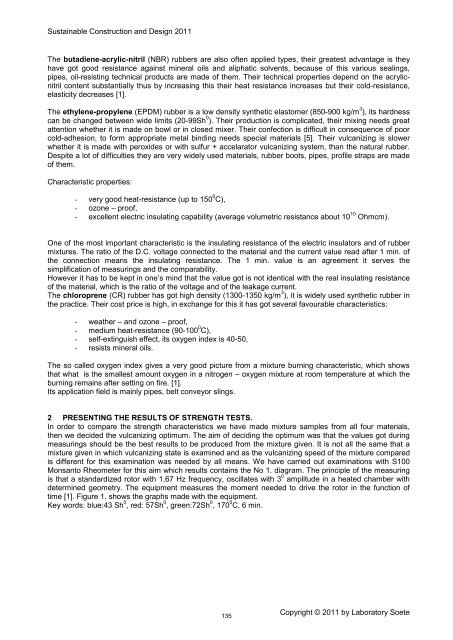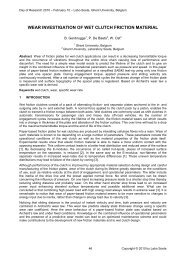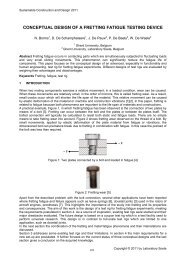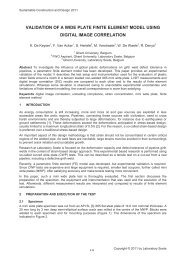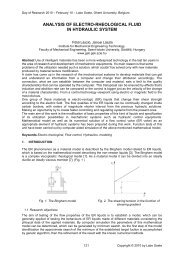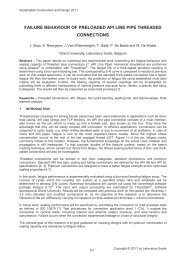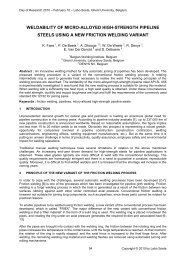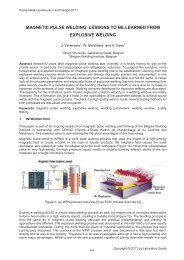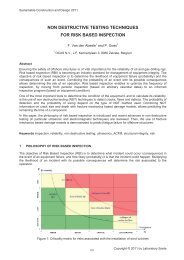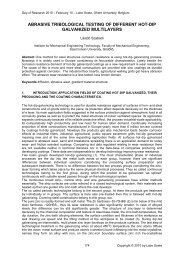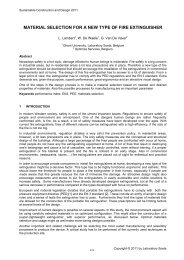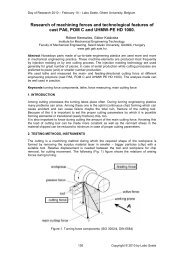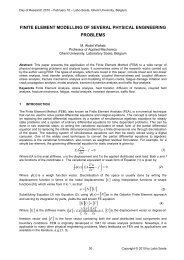Volume 2, Issue 1, 2011, Full Text - 5th International Conference on ...
Volume 2, Issue 1, 2011, Full Text - 5th International Conference on ...
Volume 2, Issue 1, 2011, Full Text - 5th International Conference on ...
Create successful ePaper yourself
Turn your PDF publications into a flip-book with our unique Google optimized e-Paper software.
Sustainable C<strong>on</strong>structi<strong>on</strong> and Design <str<strong>on</strong>g>2011</str<strong>on</strong>g><br />
The butadiene-acrylic-nitril (NBR) rubbers are also often applied types, their greatest advantage is they<br />
have got good resistance against mineral oils and aliphatic solvents, because of this various sealings,<br />
pipes, oil-resisting technical products are made of them. Their technical properties depend <strong>on</strong> the acrylicnitril<br />
c<strong>on</strong>tent substantially thus by increasing this their heat resistance increases but their cold-resistance,<br />
elasticity decreases [1].<br />
The ethylene-propylene (EPDM) rubber is a low density synthetic elastomer (850-900 kg/m 3 ), its hardness<br />
can be changed between wide limits (20-99Sh 0 ). Their producti<strong>on</strong> is complicated, their mixing needs great<br />
attenti<strong>on</strong> whether it is made <strong>on</strong> bowl or in closed mixer. Their c<strong>on</strong>fecti<strong>on</strong> is difficult in c<strong>on</strong>sequence of poor<br />
cold-adhesi<strong>on</strong>, to form appropriate metal binding needs special materials [5]. Their vulcanizing is slower<br />
whether it is made with peroxides or with sulfur + accelarator vulcanizing system, than the natural rubber.<br />
Despite a lot of difficulties they are very widely used materials, rubber boots, pipes, profile straps are made<br />
of them.<br />
Characteristic properties:<br />
- very good heat-resistance (up to 150 0 C),<br />
- oz<strong>on</strong>e – proof,<br />
- excellent electric insulating capability (average volumetric resistance about 10 10 Ohmcm).<br />
One of the most important characteristic is the insulating resistance of the electric insulators and of rubber<br />
mixtures. The ratio of the D.C. voltage c<strong>on</strong>nected to the material and the current value read after 1 min. of<br />
the c<strong>on</strong>necti<strong>on</strong> means the insulating resistance. The 1 min. value is an agreement it serves the<br />
simplificati<strong>on</strong> of measurings and the comparability.<br />
However it has to be kept in <strong>on</strong>e’s mind that the value got is not identical with the real insulating resistance<br />
of the material, which is the ratio of the voltage and of the leakage current.<br />
The chloroprene (CR) rubber has got high density (1300-1350 kg/m 3 ), it is widely used synthetic rubber in<br />
the practice. Their cost price is high, in exchange for this it has got several favourable characteristics:<br />
- weather – and oz<strong>on</strong>e – proof,<br />
- medium heat-resistance (90-100 0 C),<br />
- self-extinguish effect, its oxygen index is 40-50,<br />
- resists mineral oils.<br />
The so called oxygen index gives a very good picture from a mixture burning characteristic, which shows<br />
that what is the smallest amount oxygen in a nitrogen – oxygen mixture at room temperature at which the<br />
burning remains after setting <strong>on</strong> fire. [1].<br />
Its applicati<strong>on</strong> field is mainly pipes, belt c<strong>on</strong>veyor slings.<br />
2 PRESENTING THE RESULTS OF STRENGTH TESTS.<br />
In order to compare the strength characteristics we have made mixture samples from all four materials,<br />
then we decided the vulcanizing optimum. The aim of deciding the optimum was that the values got during<br />
measurings should be the best results to be produced from the mixture given. It is not all the same that a<br />
mixture given in which vulcanizing state is examined and as the vulcanizing speed of the mixture compared<br />
is different for this examinati<strong>on</strong> was needed by all means. We have carried out examinati<strong>on</strong>s with S100<br />
M<strong>on</strong>santo Rheometer for this aim which results c<strong>on</strong>tains the No 1. diagram. The principle of the measuring<br />
is that a standardized rotor with 1,67 Hz frequency, oscillates with 3 0 amplitude in a heated chamber with<br />
determined geometry. The equipment measures the moment needed to drive the rotor in the functi<strong>on</strong> of<br />
time [1]. Figure 1. shows the graphs made with the equipment.<br />
Key words: blue:43 Sh 0 , red: 57Sh 0 , green:72Sh 0 , 170 0 C, 6 min.<br />
135<br />
Copyright © <str<strong>on</strong>g>2011</str<strong>on</strong>g> by Laboratory Soete


